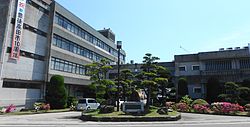Bungotakada
|
Bungotakada 豊後高田市 |
|||
|---|---|---|---|
| City | |||

Bungotakada city hall
|
|||
|
|||
 Location of Bungotakada in Ōita Prefecture |
|||
| Location in Japan | |||
| Coordinates: 33°33′N 131°27′E / 33.550°N 131.450°ECoordinates: 33°33′N 131°27′E / 33.550°N 131.450°E | |||
| Country | Japan | ||
| Region | Kyushu | ||
| Prefecture | Ōita Prefecture | ||
| Government | |||
| • Mayor | Katsuji Shutō (since April 2009) | ||
| Area | |||
| • Total | 206.65 km2 (79.79 sq mi) | ||
| Population (March 31, 2017) | |||
| • Total | 23,059 | ||
| • Density | 110/km2 (290/sq mi) | ||
| Symbols | |||
| • Tree | Diospyros kaki | ||
| • Flower | Cosmos | ||
| Time zone | Japan Standard Time (UTC+9) | ||
| City hall address | 1650 Ōji-Aiai, Bungotakada-shi, Ōita-ken 878-8555 |
||
| Website | www |
||
Bungotakada (豊後高田市? Bungotakada-shi) is a city located in Ōita Prefecture, Kyushu, Japan.
As of March 31, 2017, the city has an estimated population of 23,059, with 10,595 households and a population density of 110 persons per km². The total area is 206.65 km².
On March 31, 2005, the towns of Kakaji and Matama (both from Nishikunisaki District) were merged into Bungotakada.
Bungotakada is known for negi (Welsh onions).
Historic sites include Fuki-ji, Maki Ōdō, and Kumano magaibutsu.
The Shōwa Style Town Visitor Attraction (Shōwa no Machi in Japanese) is also a famous sightseeing spot.
...
Wikipedia



